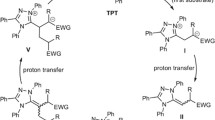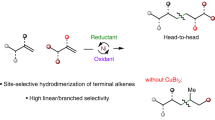Abstract
The reversible deactivation process is the essence of a variety of modern polymerization technologies, which have found wide applications in both academia and industry. However, this process seldom employs hydrogen atoms as the chain-end groups due to the lack of effective control in carbon–hydrogen functionalization polymerization (CHFP). Cooperative catalysis, especially the interplay between an organocatalyst and a metal complex, may offer a solution to the lack of control in CHFP. Here, we report a proof of concept in ring-opening polymerization of cyclopropanes using commercially available MgBr2 and 1,8-diazabicyclo[5.4.0]undec-7-ene (DBU) for a C(sp3)–H initiator system. This approach imparts cooperative activation towards chain-end hydrogen atoms and monomers, as well as reversible chain-end deprotonation and protonation to enable C(sp3)–H alkylation polymerization. This polymerization allows multiple-site chain growth and exhibits temperature dependence, thus providing unprecedented access to sequence-controlled copolymers.








Similar content being viewed by others
Data availability
The data supporting the findings of this study are available within the Article and its Supplementary Information.
References
Muller, A. H. E & Matyjaszewski, K. (eds) Controlled and Living Polymerizations: From Mechanisms to Applications (Wiley, 2009).
Hadjichristidis, N., Pitsikalis, M., Pispas, S. & Iatrou, H. Polymers with complex architecture by living anionic polymerization. Chem. Rev. 101, 3747–3792 (2001).
Matyjaszewski, K. & Xia, J. Atom transfer radical polymerization. Chem. Rev. 101, 2921–2990 (2001).
Kamigaito, M., Ando, T. & Sawamoto, M. Metal-catalyzed living radical polymerization. Chem. Rev. 101, 3689–3745 (2001).
Keddie, D. J., Moad, G., Rizzardo, E. & Thang, S. H. RAFT agent design and synthesis. Macromolecules 45, 5321–5342 (2012).
Aoshima, S. & Kanaoka, S. A Renaissance in living cationic polymerization. Chem. Rev. 109, 5245–5287 (2009).
Bielawski, C. W. & Grubbs, R. H. Living ring-opening metathesis polymerization. Prog. Polym. Sci. 32, 1–29 (2007).
Corrigan, N. et al. Reversible-deactivation radical polymerization (controlled/living radical polymerization): from discovery to materials design and applications. Prog. Polym. Sci. 111, 101311 (2020).
Chong, Y. K., Moad, G., Rizzardo, E. & Thang, S. H. Thiocarbonylthio end group removal from RAFT-synthesized polymers by radical-induced reduction. Macromolecules 40, 4446–4455 (2007).
Willcock, H. & O’Reilly, R. K. End group removal and modification of RAFT polymers. Polym. Chem. 1, 149–157 (2010).
Coessens, V. & Matyjaszewski, K. Dehalogenation of polymers prepared by atom transfer radical polymerization. Macromol. Rapid Commun. 20, 66–70 (1999).
Mattson, K. M. et al. Metal-free removal of polymer chain ends using light. Macromolecules 49, 8162–8166 (2016).
Carmean, R. N., Figg, C. A., Scheutz, G. M., Kubo, T. & Sumerlin, B. S. Catalyst-free photoinduced end-group removal of thiocarbonylthio functionality. ACS Macro Lett. 6, 185–189 (2017).
Li, N., Yang, S., Huang, Z. & Pan, X. Radical reduction of polymer chain-end functionality by stoichiometric N-heterocyclic carbene boranes. Macromolecules 54, 6000–6005 (2021).
Gutekunst, W. R. & Baran, P. S. C–H functionalization logic in total synthesis. Chem. Soc. Rev. 40, 1976–1991 (2011).
Yamaguchi, J., Yamaguchi, A. D. & Itami, K. C–H bond functionalization: emerging synthetic tools for natural products and pharmaceuticals. Angew. Chem. Int. Ed. 51, 8960–9009 (2012).
Wencel-Delord, J. & Glorius, F. C–H bond activation enables the rapid construction and late-stage diversification of functional molecules. Nat. Chem. 5, 369–375 (2013).
Chu, J. C. K. & Rovis, T. Complementary strategies for directed C(sp3)–H functionalization: a comparison of transition-metal-catalyzed activation, hydrogen atom transfer and carbene/nitrene transfer. Angew. Chem. Int. Ed. 57, 62–101 (2018).
Williamson, J. B., Lewis, S. E., Johnson, R. R. III, Manning, M. & Leibfarth, F. A. C–H functionalization of commodity polymers. Angew. Chem. Int. Ed. 58, 8654–8668 (2019).
Okamoto, K., Zhang, J., Housekeeper, J. B., Marder, S. R. & Luscombe, C. K. C–H arylation reaction: atom efficient and greener syntheses of π-conjugated small molecules and macromolecules for organic electronic materials. Macromolecules 46, 8059–8078 (2013).
Pouliot, J.-R., Grenier, F., Blaskovits, J. T., Beaupré, S. & Leclerc, M. Direct (hetero) arylation polymerization: simplicity for conjugated polymer synthesis. Chem. Rev. 116, 14225–14274 (2016).
Kaneko, H., Nagae, H., Tsurugi, H. & Mashima, K. End-functionalized polymerization of 2-vinylpyridine through initial C–H bond activation of N-heteroaromatics and internal alkynes by yttrium ene-diamido complexes. J. Am. Chem. Soc. 133, 19626–19629 (2011).
Yang, W. & Rånby, B. Radical living graft polymerization on the surface of polymeric materials. Macromolecules 29, 3308–3310 (1996).
Yamamoto, A., Nishiura, M., Oyamada, J., Koshino, H. & Hou, Z. Scandium-catalyzed syndiospecific chain-transfer polymerization of styrene using anisoles as a chain transfer agent. Macromolecules 49, 2458–2466 (2016).
Yang, P. & Yang, W. Surface chemoselective phototransformation of C–H bonds on organic polymeric materials and related high-tech applications. Chem. Rev. 113, 5547–5594 (2013).
Stache, E. E., Kottisch, V. & Fors, B. P. Photocontrolled radical polymerization from hydridic C–H bonds. J. Am. Chem. Soc. 142, 4581–4585 (2020).
de Meijere, A. Bonding properties of cyclopropane and their chemical consequences. Angew. Chem. Int. Ed. 18, 809–826 (1979).
Penelle, J. & Xie, T. Ring-opening polymerization of diisopropyl cyclopropane-1,1-dicarboxylate under living anionic conditions: a kinetic and mechanistic study. Macromolecules 33, 4667–4672 (2000).
Kagumba, L. C. & Penelle, J. Anionic ring-opening polymerization of alkyl 1-cyanocyclopropanecarboxylates. Macromolecules 38, 4588–4594 (2005).
Illy, N., Boileau, S., Buchmann, W., Penelle, J. & Barbier, V. Control of end groups in anionic polymerizations using phosphazene bases and protic precursors as initiating system (XH-ButP4approach): application to the ring-opening polymerization of cyclopropane-1,1-dicarboxylates. Macromolecules 43, 8782–8789 (2010).
Hayakawa, K., Matsuoka, S.-I. & Suzuki, M. Ring-opening polymerization of donor-acceptor cyclopropanes catalyzed by Lewis acids. Polym. Chem. 8, 3841–3847 (2017).
Emmerich, A., Daniliuc, C. G. & Studer, A. Synthesis of polymers bearing a chiral backbone via stereospecific ionic ring-opening polymerization of chiral donor-acceptor cyclopropanes. Macromol. Rapid Commun. 42, 2100030 (2021).
Moszner, N. & Salz, U. New developments of polymeric dental composites. Prog. Polym. Sci. 26, 535–576 (2001).
Chen, G.-S. et al. Palladium-catalyzed allylic alkylation of tert-butyl(diphenylmethylene)-glycinate with simple allyl esters under chiral phase transfer conditions. Tetrahedron Asymmetry 12, 1567–1571 (2001).
Chen, D.-F., Han, Z.-Y., Zhou, X.-L. & Gong, L.-Z. Asymmetric organocatalysis combined with metal catalysis: concept, proof of concept and beyond. Acc. Chem. Res. 47, 2365–2377 (2014).
Gong, L.-Z. (ed) Asymmetric Organo-Metal Catalysis: Concepts, Principles and Applications (Wiley, 2021).
Chen, D.-F. & Gong, L.-Z. Organo/transition-metal combined catalysis rejuvenates both in asymmetric synthesis. J. Am. Chem. Soc. 144, 2415–2437 (2022).
Zhang, Y., Miyake, G. M. & Chen, E. Y.-X. Alane-based classical and frustrated Lewis pairs in polymer synthesis: rapid polymerization of MMA and naturally renewable methylene butyrolactones to high molecular weight polymers. Angew. Chem. Int. Ed. 49, 10158–10162 (2010).
Jia, Y.-B. et al. Mechanistic aspects of initiation and deactivation in N-heterocyclic olefin mediated polymerization of acrylates with alane as activator. Macromolecules 47, 1966–1972 (2014).
Knaus, M. G. M., Giuman, M. M., Pothig, A. & Rieger, B. End of frustration: catalytic precision polymerization with highly interacting Lewis pairs. J. Am. Chem. Soc. 138, 7776–7781 (2016).
Bai, Y., He, J. & Zhang, Y. Ultra-high-molecular-weight polymers produced by the immortal phosphine-based catalyst system. Angew. Chem. Int. Ed. 57, 17230–17234 (2018).
Hong, M., Chen, J. & Chen, E. Y.-X. Polymerization of polar monomers mediated by main-group Lewis acid-base pairs. Chem. Rev. 118, 10551–10616 (2018).
Zhao, W., He, J. & Zhang, Y. Lewis pairs polymerization of polar vinyl monomers. Sci. Bull. 64, 1830–1840 (2019).
McGraw, M. L. & Chen, E. Y.-X. Lewis pair polymerization: perspective on a ten-year journey. Macromolecules 53, 6102–6122 (2020).
Piedra-Arroni, E. et al. A dual organic/organometallic approach for catalytic ring-opening polymerization. Chem. Commun. 47, 9828–9830 (2011).
Piedra-Arroni, E., Amgoune, A. & Bourissou, D. Dual catalysis: new approaches for the polymerization of lactones and polar olefins. Dalton Trans. 42, 9024–9029 (2013).
Piedra-Arroni, E., Ladavière, C., Amgoune, A. & Bourissou, D. Ring-opening polymerization with Zn(C6F5)2-based Lewis pairs: original and efficient approach to cyclic polyesters. J. Am. Chem. Soc. 135, 13306–13309 (2013).
Naumann, S., Scholten, P. B. V., Wilson, J. A. & Dove, A. P. Dual catalysis for selective ring-opening polymerization of lactones: evolution toward simplicity. J. Am. Chem. Soc. 137, 14439–14445 (2015).
Naumann, S. & Wang, D. Dual catalysis based on N-heterocyclic olefins for the copolymerization of lactones: high performance and tunable selectivity. Macromolecules 49, 8869–8878 (2016).
Lohmeijer, B. G. G. et al. Guanidine and amidine organocatalysts for ring-opening polymerization of cyclic esters. Macromolecules 39, 8574–8583 (2006).
Pappuru, S. & Chakraborty, D. Progress in metal-free cooperative catalysis for the ring-opening copolymerization of cyclic anhydrides and epoxides. Eur. Polym. J. 121, 109276 (2019).
Basterretxea, A., Jehanno, C., Mecerreyes, D. & Sardon, H. Dual organocatalysts based on ionic mixtures of acids and bases: a step toward high temperature polymerizations. ACS Macro Lett. 8, 1055–1062 (2019).
Liu, S. et al. Biased Lewis pairs: a general catalytic approach to ether-ester block copolymers with unlimited ordering of sequences. Angew. Chem. Int. Ed. 58, 15478–15487 (2019).
Zhang, J., Wang, L., Liu, S., Kang, X. & Li, Z. A Lewis pair as organocatalyst for one-pot synthesis of block copolymers from a mixture of epoxide, anhydride and CO2. Macromolecules 54, 763–772 (2021).
Reetz, M. T., Knauf, T., Minet, U. & Bingel, C. Metal-free carbanion salts as initiators for the anionic polymerization of acrylic and methacrylic acid esters. Angew. Chem. Int. Ed. 27, 1373–1374 (1988).
Bandermann, F. et al. Functionalized initiators for group transfer and metal-free anionic polymerization for the synthesis of macromonomers: overview and new results. Macromol. Chem. Phys. 196, 2335–2347 (1995).
Sivaram, S. et al. Tailoring carbanion structures for controlled anionic polymerization of acrylonitrile. Macromolecules 24, 1697–1698 (1991).
Baskaran, D., Chakrapani, S. & Sivaram, S. Anionic polymerization of alkyl (meth)acrylates using metal-free initiators: effect of ion pairing on initiation equilibria. Macromolecules 32, 2865–2871 (1999).
Chen, D.-F., Boyle, B. M., McCarthy, B. G., Lim, C.-H. & Miyake, G. M. Controlling polymer composition in organocatalyzed photoredox radical ring-opening polymerization of vinylcyclopropanes. J. Am. Chem. Soc. 141, 13268–13277 (2019).
Lutz, J.-F. (ed) Sequence-Controlled Polymers (Wiley, 2017).
Deacy, A. C., Gregory, G. L., Sulley, G. S., Chen, T. T. D. & Williams, C. K. Sequence control from mixtures: switchable polymerization catalysis and future materials applications. J. Am. Chem. Soc. 143, 10021–10040 (2021).
Hu, C., Pang, X. & Chen, X. Self-switchable polymerization: a smart approach to sequence-controlled degradable copolymers. Macromolecules 55, 1879–1893 (2022).
McGraw, M. L., Clarke, R. W. & Chen, E. Y.-X. Compounded sequence control in polymerization of one-pot mixtures of highly reactive acrylates by differentiating Lewis pairs. J. Am. Chem. Soc. 142, 5969–5973 (2020).
Li, C., Zhao, W., He, J., Zhang, Y. & Zhang, W. Single-step expeditious synthesis of diblock copolymers with different morphologies by Lewis pair polymerization-induced self-assembly. Angew. Chem. Int. Ed. 61, e202202448 (2022).
Wan, Y., He, J. & Zhang, Y. An arbitrarily regulated monomer sequence in multi-block copolymer synthesis by frustrated Lewis pairs. Angew. Chem. Int. Ed. 62, e202218248 (2023).
Acknowledgements
This work was supported by the National Natural Science Foundation of China (no. 22101273 to D.-F.C. and 21831007 to L.-Z.G.), the Anhui Provincial Natural Science Foundation (no. 2108085MB30 to D.-F.C.) and startup funding from the University of Science and Technology of China (D.-F.C.).
Author information
Authors and Affiliations
Contributions
D.-F.C. and L.-Z.G. conceived the idea of the project. Y.-Y.L. and T.X. synthesized the monomers. Y.-Y.L. performed the polymerizations and data analysis. L.Z. and S.-Q.Z. performed the DFT calculations. D.-F.C. and L.-Z.G. directed the investigations and co-wrote the manuscript.
Corresponding authors
Ethics declarations
Competing interests
The authors declare no competing interests.
Peer review
Peer review information
Nature Synthesis thanks Yves Gnanou and the other, anonymous, reviewer(s) for their contribution to the peer review of this work. Primary Handling Editor: Peter Seavill, in collaboration with the Nature Synthesis team.
Additional information
Publisher’s note Springer Nature remains neutral with regard to jurisdictional claims in published maps and institutional affiliations.
Supplementary information
Supplementary Information
Experimental Details, Figs. 1–74 and Tables 1–13.
Rights and permissions
Springer Nature or its licensor (e.g. a society or other partner) holds exclusive rights to this article under a publishing agreement with the author(s) or other rightsholder(s); author self-archiving of the accepted manuscript version of this article is solely governed by the terms of such publishing agreement and applicable law.
About this article
Cite this article
Li, YY., Xie, T., Zhu, L. et al. Organo–metal cooperative catalysis for C(sp3)–H alkylation polymerization. Nat. Synth 2, 1232–1242 (2023). https://doi.org/10.1038/s44160-023-00389-1
Received:
Accepted:
Published:
Issue Date:
DOI: https://doi.org/10.1038/s44160-023-00389-1
- Springer Nature Limited





